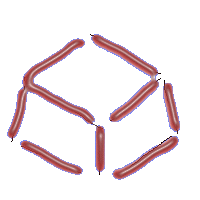|
Diacritic Tutorial
Let's assume that you want to make two accented
versions of a letter c:
1. the first: č
2. the second: ç
The usual way is to make two accents (" ˇ " and
" ¸ " ), to place them on the keyboard and to configure them
to create accented characters (" č " and " ç ") when pressed together with
the " c " character. You will actually achieve the following goal: to produce "
č " character, by pressing the " ˇ " accent followed by the " c " key (and the
same for " ç " character).
To do that, you will
need to make two accents: " ˇ " and " ¸ " on the following
key combinations:
1. " ˇ " on AltGr+1 and
2. " ¸ " on
AltGr+2.
This means that you will:
- start KLM and edit some keyboard,
- enable AltGr usage by checking the "AltGr used"
check box (skip this step if it is already checked),
- click on the "1" button
- click on the AltGr button
- find on the Character Map " ˇ " character (subset
2, Unicode index 711) and click on it,
- check the dead key check box on the right to the
AltGr button (far right on the Edit Keyboard Window):
- start diacritic editor by clicking on the
appropriate button( ) )
- click on the Add button,
- click on the first column (Char column) and then
click on the " c " character in the Character Map
- click on the second column (Composed column) and
then click on the " č " character (subset 1, Unicode index 269)
You will have something like:
- click the OK button and this will make the first
accented character (" č " character).
If you save the layout and restart computer, you
will have the following procedure for getting the " č " character:
- start Microsoft Word (or some other text
editor),
- switch to that keyboard you edited using KLM
(skip this step if you have only one keyboard),
- Hold AltGr (right Alt) and press "1"
key,
- nothing will happen (since it is a dead key), but
after that,
- release AltGr key and press "c" key.
On the screen, you will see the " č "
character.
Now, the same procedure for the
second accented character:
- start KLM and edit that same keyboard you
edited,
- click on the "2" button
- click on the AltGr button
- find on the Character Map " ¸
" character (subset 0, Unicode index 184) and click on it,
- check the dead key check box on the right to the
AltGr button (far right on the Edit Keyboard Window):
- start diacritic editor by clicking on the
appropriate button( ) )
- click on the Add button,
- click on the first column (Char column) and then
click on the " c " character in the Character Map
- click on the second column (Composed column) and
then click on the " ç " character (subset 0, Unicode index
231)
You will have something like:
- click the OK button and this will make the first
accented character (" ç " character).
If you save the layout and restart computer, you
will have the following procedure for getting the " ç "
character:
- start Microsoft Word (or some other text
editor),
- switch to that keyboard you edited using KLM
(skip this step if you have only one keyboard),
- Hold AltGr (right Alt) and press "2"
key,
- nothing will happen (since it is a dead key), but
after that,
- release AltGr key and press "c" key.
On the screen, you will see the " ç "
character.
So, you can have as much as you want accented
combinations for one letter, as long as you define all the appropriate dead keys
and configure them using the diacritic editor.
Q: Why I placed accents on AltGr+1 and AltGr+2 key
combinations?
A: Well, it is not a good practice to place accents
on a normal key, since all keys are already reserved for some character. So, it
is better to place accents on some key combinations, and AltGr+key is the usual
key combination for getting some additional characters.
Q: Is it necessary to check the dead key check box
on the right part of the window?
A: You need to check it. Otherwise, you will not
have dead key - it will simply produce an accent, and will not produce accented
character.
This program is
made by M. Vidakovic
and I. Milijasevic. This
program is shareware.
|  Keyboard Layout
Manager
Keyboard Layout
Manager  Keyboard Layout
Manager
Keyboard Layout
Manager